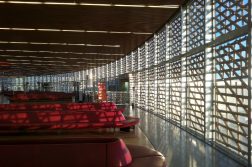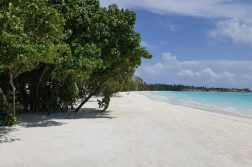Fancy a trip to the end of the world? Finistère was made famous by the Radio Four shipping forecast, and it’s just one of the highlights of a visit to Brittany. From shrimp fishing to Roman Baths to chocolate potatoes, Alice Cullerne Bown, who blogs at Dulwich Divorcee.com, discovered a world of treats…
Brittany: A trip to the end of the world
We were at a wedding in late Spring bemoaning the fact that we still hadn’t got our summer holiday organised. ‘Oh, come to Brittany, with us,’ said friends, trotting out the name of the place they’d booked. I asked TL to write it down, but he swore he’d remember it. The next day, I found him poring over a map of Brittany, with a very worried look on his face. ‘It began with a P …’ he said.
It turns out the coast of Brittany is positively pixilated with places beginning with P. We eventually found a lovely holiday house in Plestin-les-Greves, a seaside town on the Cote D’Armour. Our friends were 20 minutes’ drive away in Plougasnou, which falls into the Finistère region. Finistère, which is mentioned in the nightly Radio 4 shipping forecast, was named by the Romans who believed that this rocky, wild coast signalled the end of the world, or ‘finis terre’ in Latin.
The Romans had a point. The combination of towering cliffs, boulders that look as though they’ve dropped from a giant’s hand and roads framing the sea is both beautiful and dramatic. From a practical point of view for small children, we found some wonderful beaches between Plestin and Plougasnou. My favourite was at Poul Rodou, where there was a very nice cafe, Caplan and Co, selling second-hand books and supplying essentials like Breton crepes which soon became family favourites. In fact, a balanced Breton diet seemed to be a galette (savoury pancake) followed by a crepe (sweet pancake), at least three times a day. Caplan and Co also offered the speciality seaweed galette that the area is famous for – and no, I wasn’t brave enough to try one.
Simple pleasures
There were also great beaches with golden sand at Locquirec, Prajou and Les Sables Blancs. Quite a few beaches were dog friendly (our friends had brought their pooch).
When we touched down at Dinard Airport – a tiny Art Deco place with a very nice restaurant – a family who were returning home gave us their shrimping nets, and we soon realised that shrimping in the little rock pools was a brilliant way to spend a morning – always keeping an eye on the fast-moving tides.
It would be silly to pretend that the weather is not a factor in Brittany. All the supermarkets sell ranges of tea towels celebrating the notorious Breton rain which are hilarious when it’s sunny, not so droll when it lashes down. While the sun was shining, the beaches were enough, but we needed alternatives on the days when it refused to put its hat on.
History and stories
Luckily, there was plenty to do around Plestin. The Roman baths at nearby Hogolo, built in AD100 with the most amazing view of the sea, were worth a look even on a drizzly day. We did also plan a visit to the fountain of St Efflam, which has been part of Arthurian legend since about AD 460 (the Irish saint Efflam caused the fountain to appear when Arthur was thirsty after battling a dragon) but also now has a more recent, picturesque local story attached. Apparently, if a village maiden drops the end of her baguette into the fountain, the crumbs will miraculously spell out the name of her future husband. Unfortunately we forgot to bring our bread, and then, perhaps fortuitously, couldn’t find the fountain. In the end, the rain cleared and we discovered the beach at nearby Locquirec instead.
With teenage girls as well as small children in tow, I had to factor in a few trips to recognisable shops. We really liked Morlaix, which was about 20k away and is a small, but pretty town with a department store and a few branches of big French chains like Esprit. It has a huge and impressive viaduct running through its centre and a pretty marina ringed with boats. It also had tearooms selling chocolates in the shape of moules frites and even boiled potatoes – popular with us all.
I was glad we had finally tried Brittany. It turned out to be an easy holiday for all ages, which is not to be sniffed at with children ranging from 19 to 8. We all fell a little in love with the blue shutters, pink hydrangeas and golden crepes of Finistere, and even the rain wasn’t the end of the world. So we left our shrimping nets at the airport for the next family to collect – and maybe they’ll still be there, next time we come.



